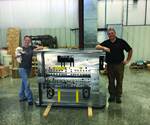Electronics Revenue Projects Modest Growth in 2018
Forecasts of electronics industry spending have steadied, but recent Gardner data signals expansion may be just ahead.
Excluding projections for Apple Inc., Gardner Intelligence’s review of Wall Street’s forecasts for 136 publicly traded electronics industry and industry-related firms indicates that growth in the electronics industry is projected to slow in 2018. From this data, expectations are that industry revenue growth in 2018 will be muted compared to the robust expansion that the industry experienced in 2017.
Data from the Gardner Business Index (GBI) corroborates this view, as the average GBI reading from our electronics industry participants in 2016 registered 51.5, which indicated only slight industry expansion, and the 2017 average reading of 55.2 represented the fastest annual expansion rate for the industry since at least 2012. To provide context, recall that the Gardner Business Index is a diffusion index in which a reading of 50.0 indicates no change, but readings that deviate from 50 indicate industry expansion or contraction. A reading reflects a more rapid rate of expansion or contraction the more that the reading deviates from 50, which shows that a reading of 55.2 can be noteworthy.
Gardner’s review of capital spending data by job shops and fabricators servicing the electronics industry suggests that shops with fewer than 50 employees at the beginning of 2018 left their 12-month projections on capital spending statistically unchanged when compared to their spending expectations from one year ago. During the first quarter of 2017, the average projected capital investment spending per plant over the next 12 months was between $300,000 and $400,000. For comparison, data from the latest three months ending with January indicates that expected capital spending has not materially changed. Among larger facilities, capital expenditure projections increased only for firms with 50–99 employees but not for any of the plant size categories above 100 people.
Although the above measures point to a modest 2018 for the electronics industry, data from job shops and fabricators that supply the electronics industry and that participate in the Gardner Business Index signify that the fourth quarter of 2017 experienced strong expansion in production, new orders and supplier deliveries. The average fourth-quarter GBI reading of 58.1 solely among shops and fabricators that serve the electronics industry represented the fastest rate of expansion for the electronics industry during a single quarter in the history of the GBI. Recent headline announcements of new capital investment by consumer and industrial electronics manufacturers during the early weeks of 2018 imply that capital spending and growth in the electronics industry may yet challenge the expectation of equities
analysts.
About the Author
Michael Guckes
Michael Guckes is the chief economist for Gardner Intelligence, a division of Gardner Business Media (Cincinnati, Ohio, United States). He has performed economic analysis, modeling and forecasting work for nearly 20 years among a range of industries. He is available at mguckes@gardnerweb.com.
Related Content
-
The Connector Conundrum: 3D Printed Mold Tooling’s Role in Innovation
ReelView Fishing faced an electronics obstacle in the development of its new technology for underwater video. Additive manufacturing for moldmaking enabled the speed necessary to iterate to a solution.
-
MMT Chats: 5 in 5 with Neu Dynamics
MoldMaking Technology editorial director Christina Fuges chats with Kevin Hartsoe, president of Neu Dynamics to reveal their five best practices for improving efficiencies in culture, technology, process, measuring success and staying competitive ... in 5 minutes.
-
Thriving on First-Off Molding Projects
Christina Fuges talks to Kevin Hartsoe, president of Neu Dynamics in Ivyland, Pennsylvania, about the company’s focus on the electric vehicle market, the key to its success, projects in the pipeline as well as supply chain and workforce challenges.

.jpg;width=70;height=70;mode=crop)













